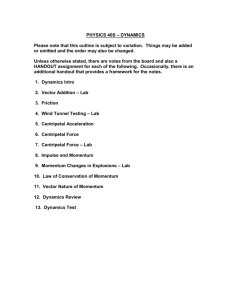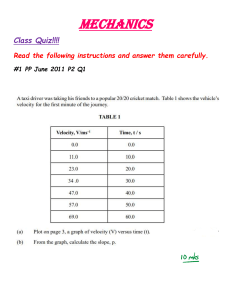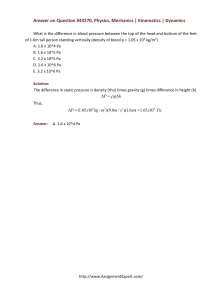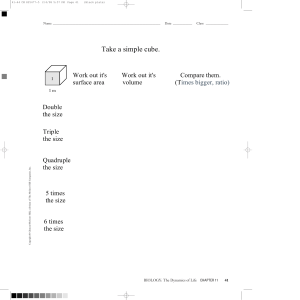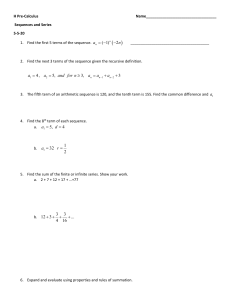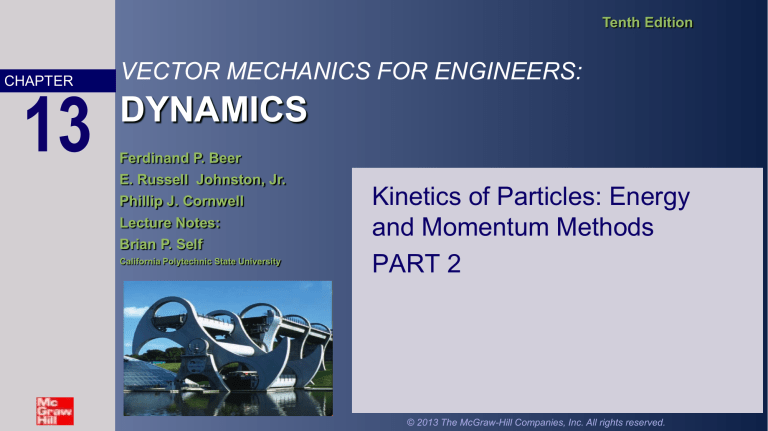
Tenth Edition CHAPTER 13 VECTOR MECHANICS FOR ENGINEERS: DYNAMICS Ferdinand P. Beer E. Russell Johnston, Jr. Phillip J. Cornwell Lecture Notes: Brian P. Self California Polytechnic State University Kinetics of Particles: Energy and Momentum Methods PART 2 © 2013 The McGraw-Hill Companies, Inc. All rights reserved. Tenth Edition Vector Mechanics for Engineers: Dynamics The potential energy stored at the top of the roller coaster is transferred to kinetic energy as the cars descend. © 2013 The McGraw-Hill Companies, Inc. All rights reserved. The elastic potential energy stored in the trampoline is transferred to kinetic energy and gravitational potential energy as the girl flies upwards. 2-2 Tenth Edition Vector Mechanics for Engineers: Dynamics Potential Energy If the work of a force only depends on differences in position, we can express this work as potential energy. Can the work done by the following forces be expressed as potential energy? Weight Yes No Friction Yes No Normal force Yes No Spring force Yes No © 2013 The McGraw-Hill Companies, Inc. All rights reserved. 2-3 Tenth Edition Vector Mechanics for Engineers: Dynamics Potential Energy • Work of the force of gravity W, U12 W y1 W y2 • Work is independent of path followed; depends only on the initial and final values of Wy. V g Wy potential energy of the body with respect to force of gravity. U12 V g Vg 1 2 • Choice of datum from which the elevation y is measured is arbitrary. • Units of work and potential energy are the same: Vg Wy N m J © 2013 The McGraw-Hill Companies, Inc. All rights reserved. 13 - 4 Tenth Edition Vector Mechanics for Engineers: Dynamics Potential Energy • Previous expression for potential energy of a body with respect to gravity is only valid when the weight of the body can be assumed constant. • For a space vehicle, the variation of the force of gravity with distance from the center of the earth should be considered. • Work of a gravitational force, GMm GMm U12 r2 r1 • Potential energy Vg when the variation in the force of gravity can not be neglected, GMm WR 2 Vg r r © 2013 The McGraw-Hill Companies, Inc. All rights reserved. 13 - 5 Tenth Edition Vector Mechanics for Engineers: Dynamics Potential Energy • Work of the force exerted by a spring depends only on the initial and final deflections of the spring, U12 12 kx12 12 kx22 • The potential energy of the body with respect to the elastic force, Ve 12 kx 2 U12 Ve 1 Ve 2 • Note that the preceding expression for Ve is valid only if the deflection of the spring is measured from its undeformed position. © 2013 The McGraw-Hill Companies, Inc. All rights reserved. 13 - 6 Tenth Edition Vector Mechanics for Engineers: Dynamics Conservation of Energy • Work of a conservative force, U12 V1 V2 • Concept of work and energy, U12 T2 T1 • Follows that T1 V1 T2 V2 E T V constant T1 0 V1 W T1 V1 W T2 12 mv22 1W 2 g W V2 0 2g T2 V2 W • When a particle moves under the action of conservative forces, the total mechanical energy is constant. • Friction forces are not conservative. Total mechanical energy of a system involving friction decreases. • Mechanical energy is dissipated by friction into thermal energy. Total energy is constant. © 2013 The McGraw-Hill Companies, Inc. All rights reserved. 13 - 7 Tenth Edition Vector Mechanics for Engineers: Dynamics Motion Under a Conservative Central Force • When a particle moves under a conservative central force, both the principle of conservation of angular momentum r0 mv0 sin 0 rmv sin and the principle of conservation of energy T0 V0 T V 1 mv 2 0 2 GMm 1 2 GMm 2 mv r0 r may be applied. • Given r, the equations may be solved for v and j. • At minimum and maximum r, j 90o. Given the launch conditions, the equations may be solved for rmin, rmax, vmin, and vmax. © 2013 The McGraw-Hill Companies, Inc. All rights reserved. 13 - 8 Tenth Edition Vector Mechanics for Engineers: Dynamics Sample Problem 13.6 SOLUTION: • Apply the principle of conservation of energy between positions 1 and 2. • The elastic and gravitational potential energies at 1 and 2 are evaluated from the given information. The initial kinetic energy is zero. A 20 lb collar slides without friction along a vertical rod as shown. The spring attached to the collar has an undeflected length of 4 in. and a constant of 3 lb/in. • Solve for the kinetic energy and velocity at 2. If the collar is released from rest at position 1, determine its velocity after it has moved 6 in. to position 2. © 2013 The McGraw-Hill Companies, Inc. All rights reserved. 13 - 9 Tenth Edition Vector Mechanics for Engineers: Dynamics Sample Problem 13.6 SOLUTION: • Apply the principle of conservation of energy between positions 1 and 2. Position 1: Ve 12 kx12 12 3 lb in.8 in. 4 in.2 24 in. lb V1 Ve Vg 24 in. lb 0 2 ft lb T1 0 Position 2: Ve 12 kx22 12 3 lb in.10 in. 4 in.2 54 in. lb Vg Wy 20 lb 6 in. 120 in. lb V2 Ve Vg 54 120 66 in. lb 5.5 ft lb T2 12 mv22 1 20 2 v2 0.311v22 2 32.2 Conservation of Energy: T1 V1 T2 V2 0 2 ft lb 0.311v22 5.5 ft lb v2 4.91ft s © 2013 The McGraw-Hill Companies, Inc. All rights reserved. 13 - 10 Tenth Edition Vector Mechanics for Engineers: Dynamics Sample Problem 13.7 SOLUTION: • Since the pellet must remain in contact with the loop, the force exerted on the pellet must be greater than or equal to zero. Setting the force exerted by the loop to zero, solve for the minimum velocity at D. The 0.5 lb pellet is pushed against the spring and released from rest at A. Neglecting friction, determine the smallest deflection of the spring for which the pellet will travel around the loop and remain in contact with the loop at all times. © 2013 The McGraw-Hill Companies, Inc. All rights reserved. • Apply the principle of conservation of energy between points A and D. Solve for the spring deflection required to produce the required velocity and kinetic energy at D. 13 - 11 Tenth Edition Vector Mechanics for Engineers: Dynamics Sample Problem 13.7 SOLUTION: • Setting the force exerted by the loop to zero, solve for the minimum velocity at D. 2 Fn man : W man mg m vD r 2 vD rg 2 ft 32.2 ft s 64.4 ft 2 s 2 • Apply the principle of conservation of energy between points A and D. V1 Ve Vg 12 kx2 0 12 36 lb ft x 2 18 x 2 T1 0 V2 Ve Vg 0 Wy 0.5 lb 4 ft 2 ft lb 2 T2 12 mvD 1 0.5 lb 2 2 64 . 4 ft s 0.5 ft lb 2 32.2 ft s 2 T1 V1 T2 V2 0 18 x 2 0.5 2 © 2013 The McGraw-Hill Companies, Inc. All rights reserved. x 0.3727 ft 4.47 in. 13 - 12 Tenth Edition Vector Mechanics for Engineers: Dynamics Sample Problem 13.9 SOLUTION: • For motion under a conservative central force, the principles of conservation of energy and conservation of angular momentum may be applied simultaneously. A satellite is launched in a direction parallel to the surface of the earth with a velocity of 36900 km/h from an altitude of 500 km. • Apply the principles to the points of minimum and maximum altitude to determine the maximum altitude. • Apply the principles to the orbit insertion point and the point of minimum altitude to determine maximum allowable orbit Determine (a) the maximum altitude insertion angle error. reached by the satellite, and (b) the maximum allowable error in the direction of launching if the satellite is to come no closer than 200 km to the surface of the earth © 2013 The McGraw-Hill Companies, Inc. All rights reserved. 13 - 13 Tenth Edition Vector Mechanics for Engineers: Dynamics Sample Problem 13.9 • Apply the principles of conservation of energy and conservation of angular momentum to the points of minimum and maximum altitude to determine the maximum altitude. Conservation of energy: TA VA TA VA 1 mv 2 0 2 GMm 1 2 GMm 2 mv1 r0 r1 Conservation of angular momentum: r r0mv0 r1mv1 v1 v0 0 r1 Combining, 2 r0 2GM 1 v 2 1 r0 GM 1 r0 1 2 0 2 r0 r1 r1 r0v02 r1 r0 6370 km 500 km 6870 km v0 36900 km h 10.25 106 m s 2 GM gR 2 9.81m s 2 6.37 106 m 398 1012 m3 s 2 r1 60.4 106 m 60400 km © 2013 The McGraw-Hill Companies, Inc. All rights reserved. 13 - 14 Tenth Edition Vector Mechanics for Engineers: Dynamics Sample Problem 13.9 • Apply the principles to the orbit insertion point and the point of minimum altitude to determine maximum allowable orbit insertion angle error. Conservation of energy: GMm 1 mv 2 GMm 1 mv 2 T0 V0 TA VA 0 max 2 2 r0 rmin Conservation of angular momentum: r r0mv0 sin 0 rmin mvmax vmax v0 sin 0 0 rmin Combining and solving for sin j0, sin 0 0.9801 j 0 90 11.5 © 2013 The McGraw-Hill Companies, Inc. All rights reserved. allowable error 11.5 13 - 15 Tenth Edition Vector Mechanics for Engineers: Dynamics ASSIGNMENT: Problem 1 SOLUTION: • This is two part problem – you will need to find the velocity of the car using work-energy, and then use Newton’s second law to find the normal force. A section of track for a roller coaster consists of two circular arcs AB and CD joined by a straight portion BC. The radius of CD is 240 ft. The car and its occupants, of total weight 560 lb, reach Point A with practically no velocity and then drop freely along the track. Determine the normal force exerted by the track on the car at point D. Neglect air resistance and rolling resistance. © 2013 The McGraw-Hill Companies, Inc. All rights reserved. ANSWER: N D 1260 lbs • Draw a diagram with the car at points A and D, and define your datum. Use conservation of energy to solve for vD • Draw FBD and KD of the car at point D, and determine the normal force using Newton’s second law. 2 - 16 Tenth Edition Vector Mechanics for Engineers: Dynamics Impulsive Motion The thrust of a rocket acts over a specific time period to give the rocket linear momentum. © 2013 The McGraw-Hill Companies, Inc. All rights reserved. The impulse applied to the railcar by the wall brings its momentum to zero. Crash tests are often performed to help improve safety in different vehicles. 2 - 17 Tenth Edition Vector Mechanics for Engineers: Dynamics Principle of Impulse and Momentum • From Newton’s second law, d F mv mv linear momentum dt Fdt d mv t2 F dt m v m v 2 1 t1 • Dimensions of the impulse of a force are force*time. • Units for the impulse of a force are N s kg m s s kg m s 2 © 2013 The McGraw-Hill Companies, Inc. All rights reserved. t2 Fdt Imp12 impulse of the force F t1 mv1 Imp12 mv2 • The final momentum of the particle can be obtained by adding vectorially its initial momentum and the impulse of the force during the time interval. 13 - 18 Tenth Edition Vector Mechanics for Engineers: Dynamics Impulsive Motion • Force acting on a particle during a very short time interval that is large enough to cause a significant change in momentum is called an impulsive force. • When impulsive forces act on a particle, mv1 F t mv2 • When a baseball is struck by a bat, contact occurs over a short time interval but force is large enough to change sense of ball motion. • Nonimpulsive forces are forces for which Ft is small and therefore, may be neglected – an example of this is the weight of the baseball. © 2013 The McGraw-Hill Companies, Inc. All rights reserved. 13 - 19 Tenth Edition Vector Mechanics for Engineers: Dynamics Sample Problem 13.10 SOLUTION: • Apply the principle of impulse and momentum. The impulse is equal to the product of the constant forces and the time interval. An automobile weighing 4000 lb is driven down a 5o incline at a speed of 60 mi/h when the brakes are applied, causing a constant total braking force of 1500 lb. Determine the time required for the automobile to come to a stop. © 2013 The McGraw-Hill Companies, Inc. All rights reserved. 13 - 20 Tenth Edition Vector Mechanics for Engineers: Dynamics Sample Problem 13.10 SOLUTION: • Apply the principle of impulse and momentum. mv1 Imp12 mv2 Taking components parallel to the incline, mv1 W sin 5t Ft 0 4000 88 ft s 4000sin 5t 1500t 0 32.2 t 9.49 s © 2013 The McGraw-Hill Companies, Inc. All rights reserved. 13 - 21 Tenth Edition Vector Mechanics for Engineers: Dynamics Sample Problem 13.11 SOLUTION: • Apply the principle of impulse and momentum in terms of horizontal and vertical component equations. A 4 oz baseball is pitched with a velocity of 80 ft/s. After the ball is hit by the bat, it has a velocity of 120 ft/s in the direction shown. If the bat and ball are in contact for 0.015 s, determine the average impulsive force exerted on the ball during the impact. © 2013 The McGraw-Hill Companies, Inc. All rights reserved. 13 - 22 Tenth Edition Vector Mechanics for Engineers: Dynamics Sample Problem 13.11 SOLUTION: • Apply the principle of impulse and momentum in terms of horizontal and vertical component equations. mv1 Imp12 mv2 x component equation: mv1 Fx t mv2 cos 40 4 16 80 Fx 0.15 4 16 120 cos 40 32.2 32.2 Fx 89 lb y component equation: y 0 Fy t mv2 sin 40 x © 2013 The McGraw-Hill Companies, Inc. All rights reserved. 4 16 120 cos 40 32.2 Fy 39.9 lb F 89 lb i 39.9 lb j , F 97.5 lb Fy 0.15 13 - 23 Tenth Edition Vector Mechanics for Engineers: Dynamics Sample Problem 13.12 SOLUTION: A 10 kg package drops from a chute into a 24 kg cart with a velocity of 3 m/s. Knowing that the cart is initially at rest and can roll freely, determine (a) the final velocity of the cart, (b) the impulse exerted by the cart on the package, and (c) the fraction of the initial energy lost in the impact. © 2013 The McGraw-Hill Companies, Inc. All rights reserved. • Apply the principle of impulse and momentum to the package-cart system to determine the final velocity. • Apply the same principle to the package alone to determine the impulse exerted on it from the change in its momentum. 13 - 24 Tenth Edition Vector Mechanics for Engineers: Dynamics Sample Problem 13.12 SOLUTION: • Apply the principle of impulse and momentum to the package-cart system to determine the final velocity. y x m pv1 Imp12 m p mc v2 x components: m p v1 cos 30 0 m p mc v2 10 kg 3 m/s cos 30 10 kg 25 kg v2 v2 0.742 m/s © 2013 The McGraw-Hill Companies, Inc. All rights reserved. 13 - 25 Tenth Edition Vector Mechanics for Engineers: Dynamics Sample Problem 13.12 • Apply the same principle to the package alone to determine the impulse exerted on it from the change in its momentum. y x m pv1 Imp12 m pv2 x components: m p v1 cos 30 Fx t m p v2 10 kg 3 m/s cos 30 Fx t 10 kg v2 y components: Fx t 18.56 N s m p v1 sin 30 Fy t 0 10 kg 3 m/s sin 30 Fy t 0 Imp12 Ft 18.56 N s i 15 N s j © 2013 The McGraw-Hill Companies, Inc. All rights reserved. Fy t 15 N s Ft 23.9 N s 13 - 26 Tenth Edition Vector Mechanics for Engineers: Dynamics Sample Problem 13.12 To determine the fraction of energy lost, T1 12 m p v12 T2 1 2 1 2 10 kg 3m s 45 J mp mc v22 2 1 2 10 kg 25 kg 0.742 m s 9.63 J 2 T1 T2 45 J 9.63 J 0.786 T1 45 J © 2013 The McGraw-Hill Companies, Inc. All rights reserved. 13 - 27 Tenth Edition Vector Mechanics for Engineers: Dynamics ASSIGNMENT: Problem 2 SOLUTION: • Draw impulse and momentum diagrams of the jumper. • Apply the principle of impulse and momentum to the jumper to determine the force exerted on the foot. The jumper approaches the takeoff line from the left with a horizontal velocity of 10 m/s, remains in contact with the ground for 0.18 s, and takes off at a 50o angle with a velocity of 12 m/s. Determine the average impulsive force exerted by the ground on his foot. Give your answer in terms of the weight W of the athlete. © 2013 The McGraw-Hill Companies, Inc. All rights reserved. ANSWER: Favg 1.295W i 6.21W j 2 - 28 Tenth Edition Vector Mechanics for Engineers: Dynamics ASSIGNMENT: Problem 2 (Concept question) Car A and B crash into one another. Looking only at the impact, which of the following statements are true? The total mechanical energy is the same before and after the impact If car A weighs twice as much as car B, the force A exerts on car B is bigger than the force B exerts on car A. The total linear momentum is the same immediately before and after the impact © 2013 The McGraw-Hill Companies, Inc. All rights reserved. 2 - 29 Tenth Edition Vector Mechanics for Engineers: Dynamics The coefficient of restitution is used to characterize the “bounciness” of different sports equipment. The U.S. Golf Association limits the COR of golf balls at 0.83 Civil engineers use the coefficient of restitution to model rocks falling from hillsides © 2013 The McGraw-Hill Companies, Inc. All rights reserved. 2 - 30 Tenth Edition Vector Mechanics for Engineers: Dynamics Impact • Impact: Collision between two bodies which occurs during a small time interval and during which the bodies exert large forces on each other. • Line of Impact: Common normal to the surfaces in contact during impact. Direct Central Impact • Central Impact: Impact for which the mass centers of the two bodies lie on the line of impact; otherwise, it is an eccentric impact.. • Direct Impact: Impact for which the velocities of the two bodies are directed along the line of impact. • Oblique Impact: Impact for which one or both of the bodies move along a line other than the line of impact. Oblique Central Impact © 2013 The McGraw-Hill Companies, Inc. All rights reserved. 13 - 31 Tenth Edition Vector Mechanics for Engineers: Dynamics Direct Central Impact • Bodies moving in the same straight line, vA > vB . • Upon impact the bodies undergo a period of deformation, at the end of which, they are in contact and moving at a common velocity. • A period of restitution follows during which the bodies either regain their original shape or remain permanently deformed. • Wish to determine the final velocities of the two bodies. The total momentum of the two body system is preserved, m Av A mB v B mB vB mB vB • A second relation between the final velocities is required. © 2013 The McGraw-Hill Companies, Inc. All rights reserved. 13 - 32 Tenth Edition Vector Mechanics for Engineers: Dynamics Direct Central Impact e coefficient of restitution • Period of deformation: m Av A Pdt m Au Rdt u vA Pdt v A u 0 e 1 • Period of restitution: m Au Rdt m AvA • A similar analysis of particle B yields vB u e u vB • Combining the relations leads to the desired second relation between the final velocities. vB vA ev A v B • Perfectly plastic impact, e = 0: vB vA v m Av A mB v B m A mB v • Perfectly elastic impact, e = 1: Total energy and total momentum conserved. vB vA v A v B © 2013 The McGraw-Hill Companies, Inc. All rights reserved. 13 - 33 Tenth Edition Vector Mechanics for Engineers: Dynamics Oblique Central Impact • Final velocities are unknown in magnitude and direction. Four equations are required. • No tangential impulse component; tangential component of momentum for each particle is conserved. • Normal component of total momentum of the two particles is conserved. • Normal components of relative velocities before and after impact are related by the coefficient of restitution. © 2013 The McGraw-Hill Companies, Inc. All rights reserved. v A t vA t v B t vB t m A v A n mB v B n m A vA n mB vB n vB n vA n ev A n v B n 13 - 34 Tenth Edition Vector Mechanics for Engineers: Dynamics Oblique Central Impact • Block constrained to move along horizontal surface. • Impulses from internal forces F and F along the n axis and from external force Fext exerted by horizontal surface and directed along the vertical to the surface. • Final velocity of ball unknown in direction and magnitude and unknown final block velocity magnitude. Three equations required. © 2013 The McGraw-Hill Companies, Inc. All rights reserved. 13 - 35 Tenth Edition Vector Mechanics for Engineers: Dynamics Oblique Central Impact • Tangential momentum of ball is conserved. v B t vB t • Total horizontal momentum of block and ball is conserved. m A v A mB v B x m A vA mB vB x • Normal component of relative velocities of block and ball are related by coefficient of restitution. vB n vA n ev A n v B n • Note: Validity of last expression does not follow from previous relation for the coefficient of restitution. A similar but separate derivation is required. © 2013 The McGraw-Hill Companies, Inc. All rights reserved. 13 - 36 Tenth Edition Vector Mechanics for Engineers: Dynamics Problems Involving Energy and Momentum • Three methods for the analysis of kinetics problems: - Direct application of Newton’s second law - Method of work and energy - Method of impulse and momentum • Select the method best suited for the problem or part of a problem under consideration. © 2013 The McGraw-Hill Companies, Inc. All rights reserved. 13 - 37 Tenth Edition Vector Mechanics for Engineers: Dynamics Sample Problem 13.14 SOLUTION: • Resolve ball velocity into components normal and tangential to wall. • Impulse exerted by the wall is normal to the wall. Component of ball momentum tangential to wall is conserved. A ball is thrown against a frictionless, vertical wall. Immediately before the ball strikes the wall, its velocity has a magnitude v and forms angle of 30o with the horizontal. Knowing that e = 0.90, determine the magnitude and direction of the velocity of the ball as it rebounds from the wall. © 2013 The McGraw-Hill Companies, Inc. All rights reserved. • Assume that the wall has infinite mass so that wall velocity before and after impact is zero. Apply coefficient of restitution relation to find change in normal relative velocity between wall and ball, i.e., the normal ball velocity. 13 - 38 Tenth Edition Vector Mechanics for Engineers: Dynamics Sample Problem 13.14 SOLUTION: • Resolve ball velocity into components parallel and perpendicular to wall. vn v cos 30 0.866v vt v sin 30 0.500v • Component of ball momentum tangential to wall is conserved. vt vt 0.500v t n • Apply coefficient of restitution relation with zero wall velocity. 0 vn evn 0 vn 0.90.866v 0.779v v 0.779v n 0.500v t 0.779 v 0.926v tan 1 32.7 0.500 © 2013 The McGraw-Hill Companies, Inc. All rights reserved. 13 - 39 Tenth Edition Vector Mechanics for Engineers: Dynamics Sample Problem 13.15 SOLUTION: • Resolve the ball velocities into components normal and tangential to the contact plane. • Tangential component of momentum for each ball is conserved. The magnitude and direction of the velocities of two identical frictionless balls before they strike each other are as shown. Assuming e = 0.9, determine the magnitude and direction of the velocity of each ball after the impact. © 2013 The McGraw-Hill Companies, Inc. All rights reserved. • Total normal component of the momentum of the two ball system is conserved. • The normal relative velocities of the balls are related by the coefficient of restitution. • Solve the last two equations simultaneously for the normal velocities of the balls after the impact. 13 - 40 Tenth Edition Vector Mechanics for Engineers: Dynamics Sample Problem 13.15 SOLUTION: • Resolve the ball velocities into components normal and tangential to the contact plane. v A n v A cos 30 26.0 ft s vB n vB cos 60 20.0 ft s v A t v A sin 30 15.0 ft s vB t vB sin 60 34.6 ft s • Tangential component of momentum for each ball is conserved. vA t v A t 15.0 ft s vB t vB t 34.6 ft s • Total normal component of the momentum of the two ball system is conserved. mA v A n mB vB n mA vA n mB vB n m26.0 m 20.0 mvA n mvB n vA n vB n 6.0 © 2013 The McGraw-Hill Companies, Inc. All rights reserved. 13 - 41 Tenth Edition Vector Mechanics for Engineers: Dynamics Sample Problem 13.15 • The normal relative velocities of the balls are related by the coefficient of restitution. vA n vB n ev A n vB n 0.9026.0 20.0 41.4 • Solve the last two equations simultaneously for the normal velocities of the balls after the impact. vA n 17.7 ft s vB n 23.7 ft s v A 17.7t 15.0n n 15.0 vA 23.2 ft s tan 1 40.3 17.7 vB 23.7t 34.6n t © 2013 The McGraw-Hill Companies, Inc. All rights reserved. 34.6 vB 41.9 ft s tan 1 55.6 23 . 7 13 - 42 Tenth Edition Vector Mechanics for Engineers: Dynamics Sample Problem 13.16 SOLUTION: • Determine orientation of impact line of action. • The momentum component of ball A tangential to the contact plane is conserved. • The total horizontal momentum of the two ball system is conserved. Ball B is hanging from an inextensible • The relative velocities along the line of cord. An identical ball A is released action before and after the impact are from rest when it is just touching the related by the coefficient of restitution. cord and acquires a velocity v0 before striking ball B. Assuming perfectly • Solve the last two expressions for the elastic impact (e = 1) and no friction, velocity of ball A along the line of action determine the velocity of each ball and the velocity of ball B which is immediately after impact. horizontal. © 2013 The McGraw-Hill Companies, Inc. All rights reserved. 13 - 43 Tenth Edition Vector Mechanics for Engineers: Dynamics Sample Problem 13.16 r 0.5 2r 30 sin SOLUTION: • Determine orientation of impact line of action. • The momentum component of ball A tangential to the contact plane is conserved. mv A Ft mv A mv0 sin 30 0 mvA t vA t 0.5v0 • The total horizontal (x component) momentum of the two ball system is conserved. mv A Tt mv A mvB 0 mvA t cos 30 mvA n sin 30 mvB 0 0.5v0 cos 30 vA n sin 30 vB 0.5vA n vB 0.433v0 © 2013 The McGraw-Hill Companies, Inc. All rights reserved. 13 - 44 Tenth Edition Vector Mechanics for Engineers: Dynamics Sample Problem 13.16 • The relative velocities along the line of action before and after the impact are related by the coefficient of restitution. vB n vA n ev A n vB n vB sin 30 vA n v0 cos 30 0 0.5vB vA n 0.866v0 • Solve the last two expressions for the velocity of ball A along the line of action and the velocity of ball B which is horizontal. vA n 0.520v0 vB 0.693v0 v A 0.5v0t 0.520v0n vA 0.721v0 tan 1 0.52 46.1 0.5 46.1 30 16.1 vB 0.693v0 © 2013 The McGraw-Hill Companies, Inc. All rights reserved. 13 - 45 Tenth Edition Vector Mechanics for Engineers: Dynamics Sample Problem 13.17 SOLUTION: • Apply the principle of conservation of energy to determine the velocity of the block at the instant of impact. • Since the impact is perfectly plastic, the block and pan move together at the same velocity after impact. Determine that velocity from the requirement that the total momentum of the block and pan is conserved. A 30 kg block is dropped from a height of 2 m onto the the 10 kg pan of a • Apply the principle of conservation of spring scale. Assuming the impact to be energy to determine the maximum perfectly plastic, determine the deflection of the spring. maximum deflection of the pan. The constant of the spring is k = 20 kN/m. © 2013 The McGraw-Hill Companies, Inc. All rights reserved. 13 - 46 Tenth Edition Vector Mechanics for Engineers: Dynamics Sample Problem 13.17 SOLUTION: • Apply principle of conservation of energy to determine velocity of the block at instant of impact. T1 0 V1 WA y 30 9.812 588 J T2 12 m A v A 22 12 30 v A 22 V2 0 T1 V1 T2 V2 0 588 J 12 30 v A 22 0 v A 2 6.26 m s • Determine velocity after impact from requirement that total momentum of the block and pan is conserved. mA v A 2 mB vB 2 mA mB v3 306.26 0 30 10v3 © 2013 The McGraw-Hill Companies, Inc. All rights reserved. v3 4.70 m s 13 - 47 Tenth Edition Vector Mechanics for Engineers: Dynamics Sample Problem 13.17 • Apply the principle of conservation of energy to determine the maximum deflection of the spring. T3 12 m A mB v32 12 30 10 4.7 2 442 J V3 Vg Ve 0 1 kx 2 2 3 1 2 20 10 4.91 10 3 3 2 0.241 J T4 0 Initial spring deflection due to pan weight: x3 WB 10 9.81 3 4 . 91 10 m 3 k 20 10 V4 Vg Ve WA WB h 12 kx42 392x4 4.91 103 12 20 103 x42 392 x4 x3 12 20 103 x42 T3 V3 T4 V4 442 0.241 0 392 x4 4.91 103 12 20 103 x42 x4 0.230 m h x4 x3 0.230 m 4.91 103 m © 2013 The McGraw-Hill Companies, Inc. All rights reserved. h 0.225 m 13 - 48 Tenth Edition Vector Mechanics for Engineers: Dynamics ASSIGNMENT: Problem 3 SOLUTION: • This is a multiple step problem. Formulate your overall approach. • Use work-energy to find the velocity of the block just before impact A 2-kg block A is pushed up against a spring • Use conservation of compressing it a distance x= 0.1 m. The block is momentum to determine then released from rest and slides down the 20º the speed of ball B after incline until it strikes a 1-kg sphere B, which is the impact suspended from a 1 m inextensible rope. The spring constant k=800 N/m, the coefficient of • Use work energy to find the velocity at friction between A and the ground is 0.2, the distance A slides from the unstretched length of nd the spring d=1.5 m, and the coefficient of • Use Newton’s 2 Law to find tension in the rope restitution between A and B is 0.8. When =40o, find (a) the speed of B (b) the tension in the rope. © 2013 The McGraw-Hill Companies, Inc. All rights reserved. 2 - 49 Tenth Edition Vector Mechanics for Engineers: Dynamics ASSIGNMENT: Problem 3 (Concept question) Compare the following statement to the problem you just solved. If the coefficient of restitution is smaller than the 0.8 in the problem, the tension T will be… Smaller Bigger If the rope length is smaller than the 1 m in the problem, the tension T will be… Smaller Bigger If the coefficient of friction is smaller than 0.2 given in the problem, the tension T will be… Smaller If the mass of A is smaller than the 2 kg given in the problem, the tension T will be… Smaller Bigger Bigger © 2013 The McGraw-Hill Companies, Inc. All rights reserved. 2 - 50 Tenth Edition Vector Mechanics for Engineers: Dynamics Summary Approaches to Kinetics Problems Forces and Accelerations Velocities and Displacements Velocities and Time Newton’s Second Law (last chapter) Work-Energy ImpulseMomentum F ma G © 2013 The McGraw-Hill Companies, Inc. All rights reserved. T1 U12 T2 t2 mv1 F dt mv2 t1 2 - 51
